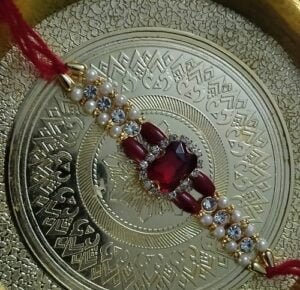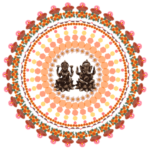India is a land of diverse festivals, each with individual charm and significance. While many other festivals honor deities, harvests, or historical events, Rakhi Purnima cherishes the unconditional love of brother-sister. Here, Rakhi refers to a protective thread. The festival is observed on the Purnima tithi (full moon day), generally in the month of Shravana. Rakhi Purnima gets its name from this auspicious timing. It is a day when siblings come together, not just by blood, but by an unbreakable tie that reflects promises, protection, and a lifelong connection. Rakhi Purnima is popularly known as ‘Raksha Bandhan’. The term ‘Raksha Bandhan’, originated from the Sanskrit language, means ‘the bond of protection, obligation, or care’.
- Date and Timing of Rakhi Purnima in 2023:
- Tagore’s Unity Initiative and Rakhi:
- Rituals of Rakhi Purnima:
- Celebration in Different Regions:
- Rakhi Celebration in Modern Time:
Date and Timing of Rakhi Purnima in 2023:
Rakhi Purnima is observed annually on the Purnima tithi of Shravana, a month of the Hindu lunar calendar. But, this year it has shifted to the next month, as this Shravana is considered a ‘Malmas’.
In 2023, Rakhi Purnima tithi falls on the 12th and 13th dates of the month of Bhadra, i.e., the 30th and 31st dates of August. According to the Shastra, the best time to perform the rituals is between 09:09 PM on August 30 and 07:05 AM on August 31.
Tagore’s Unity Initiative and Rakhi:
The great Bengali Poet, ‘Rabindranath Tagore’ envisioned this Rakhi celebration as more than just a sibling festival. He saw it as a celebration of fellow feelings and concern, promoting the responsibility to protect each other.
On 20th July 1905, the British government announced the ‘partition of Bengal’. Their actual aim was to weaken the growing Bengali community by separating Hindus and Muslims. In that situation, Kabiguru (Tagore) used Rakhi as an important means to oppose the partition. People from all religions and castes stood together to protest. In response to Tagore’s call, they would tie yellow threads around each other’s wrists as a symbol of unity. This act also helped to spread the feeling of brotherhood among them. In this manner, Tagore turned Raksha Bandhan into a movement to foster harmony and friendship between Hindus and Muslims in Bengal.
Rituals of Rakhi Purnima:

Like every Indian festival, Rakhi Purnima is also celebrated through various rituals. On this special day, many Indian sisters keep fasting to wish for their brothers’ well-being, longevity, and prosperity. The fast ends with Tyings Rakhi to their brother’s wrist. Numerous Indian families begin this auspicious day by tying rakhi to their household deities (Ganesha and Krishna) and worshipping them. After that, sisters thoughtfully arrange a rakhi thali, which contains kumkum or roli, akshata (whole grain rice), a glowing diya, a coconut, one piece of colorful cloth, sweets, and a colorful rakhi.
The sisters keep the piece of cloth on the brother’s head. They respectively put kumkum tikka and akshata tikka on the forehead of brothers by their ring finger. After that, chanting the Raksha mantra, they rotate the rakhi thali in a circular motion before their brothers called aarti. Then they tie rakhi on the right-hand wrist of their brothers and sweeten their mouths.
It is believed that- (i) kumkum is applied to promote positive and spiritual thoughts. (ii) Akshata is used to protect them from evil. (iii) The diya helps to burn the bad energies from their lives. And (iv) The rakhi, a sacred thread, symbolizes the sacred love and bond of brother-sister.
Rakhi Mantra in Rakhi Purnima:

Rakhi mantra is the sacred chant recited by the sisters while they perform aarti to their brothers. The mantra means that just like the strong King Bali was tied with a thread, the sisters are tying the rakhi to their brothers. They are also requesting the rakhi thread to stay strong and not come undone.
Celebration in Different Regions:
The sacred Hindu festival, Rakhi Purnima, is celebrated more or less in every region in India. Rakhi Purnima is also a public holiday in several regions of India. However, it takes on diverse forms based on regional and cultural nuances. In West Bengal, Rakhi Purnima is also known as ‘Jhulan Purnima’. Apart from the rakhi ceremony, on this Purnima tithi, Bengali Hindus are also focusing on the puja of Radha-Krishna. Here, this day also marks a special day to worship the idol of Radha-Krishna.
Among Maharashtra’s Koli community, Rakhi Purnima is intertwined with ‘Narali Purnima’, or the ‘coconut day festival’. Besides tying the rakhi, it is a special day for them to honor Varuna, the Hindu God of the sea. The citizens of Odisha mark this day as the birthday of Lord Balarama and refer to the day as ‘Gamha Purnima’ as well. As Lord Balarama is seen as the god of farming, farmers of Odisha tie rachis to cattle on this day.
Many north Indian states engage themselves in kite flying on the day of Rakhi Purnima. In our neighboring country Nepal, Rakhi Purnima is celebrated by both Hindus and Buddhists. Here, Rakhi Purnima is called ‘Janai Purnima’ or ‘Rishitarpani’. A festival, similar to Rakhi Purnima is also celebrated by some Nepali Hindus during the Tihar (Diwali) festival.
People also read :Rath Yatra : A Festival Of Faith, Fervour And Festivity
Rakhi Celebration in Modern Time:

A decade after a decade has passed, but the essence of Rakhi Purnima remains intact. In the digital age, distance often separates siblings, but technology bridges the gap. Siblings, who are miles apart, share their emotions through video calls and sending virtual Rakhis. On the other hand, for those siblings, who can meet, it is a great time for family gatherings and spreading joy. They observe Rakhi Purnima through all rituals and exchange gifts. Also, the concept of Tagore is still alive among our modern generation. Many educational institutions celebrate this day on their premises to promote a sense of friendship and harmony among peers.
Rakhi Purnima serves as a gentle reminder to uphold brother-sister-like bonds throughout our lives. Apart from creating a strong sense of unity among siblings, it can unite people across boundaries. Also, the diverse rituals across India reflect our Nation’s cultural richness. So, we can say that Rakhi, a colorful thread of affection, adds a special glow to India’s tradition.


